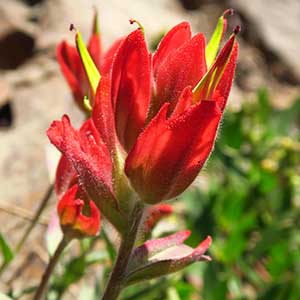Castilleja nivea
Castilleja elmeri
snow Indian paintbrush, snow paintbrush, snowy paintbrush
Elmer's Indian paintbrush, Elmer's paintbrush, Wenatchee Indian paintbrush, Wenatchee paintbrush
few to several, erect to ascending, decumbent at base, unbranched except for small, leafy axillary shoots, hairs weakly spreading to appressed, ± matted, especially distally on stem, fairly short and sparse proximally, longer and denser distally, soft, eglandular, becoming woolly, often obscuring surface.
solitary or few to many, erect to ascending, sometimes slightly curved at base, unbranched, rarely branched, hairs moderately dense, spreading, medium length, soft, mixed with shorter eglandular and stipitate-glandular ones, at least on distal 1/2 of stem.
gray with hairs, surface green to purple, linear to narrowly lanceolate, 1–3.8 cm, not fleshy, margins plane, sometimes ± wavy, involute, 0–3-lobed, apex acute;
lobes ascending-spreading, linear to narrowly lanceolate, apex acute to obtuse.
green, rarely purple-tinged, linear-lanceolate, sometimes linear or lanceolate, 1.3–6.5 cm, not fleshy, margins plane, flat or involute, entire, apex acute.
2.5–6 × 1–2.5 cm;
bracts greenish to pale yellow-green or very pale, dull purplish throughout, lanceolate to oblong, (0–)3(–5)-lobed;
lobes usually ascending, linear, medium length to long, arising near mid length, apex acute.
2.5–9 × 1.5–3 cm;
bracts red, crimson, scarlet, pink, magenta, red-orange, burnt orange, orange, pale yellow, or whitish throughout, or proximally greenish, distally as stated above, oblong, narrowly obovate, elliptic-oblong, or narrowly ovate, 0(–5)-lobed, rarely with 1 or 2 pairs of short, usually distal lobes;
lobes ascending, lanceolate, very short, arising from distal edge, apex rounded to obtuse.
0 mm.
straight, 18–25 mm;
tube 3.5–5.5 mm; subequal to calyx, or beak and sometimes abaxial lip exserted;
beak adaxially yellow, 6–8 mm, hairs moderately long, matted on midline, very short-glandular on sides;
abaxial lip green, inconspicuous, slightly pouched, 3.5–5.5 mm, 60–90% as long as beak;
teeth erect, white or yellow, 0.5–3 mm.
straight, 20–33 mm;
tubes 13–18 mm;
beak, and sometimes abaxial lip, partially to fully exserted;
beak adaxially green to yellowish, 8–15 mm;
abaxial lip incurved, green, thickened, 2–3 mm, 20–33% as long as beak;
teeth ascending or incurved, green, 0.5–1 mm.
yellow, color mostly obscured by whitish hairs, 15–22 mm;
abaxial, adaxial, and lateral clefts (5.5–)7–12 mm, 35–55% of calyx length, often appearing shorter because matted hairs stitch proximal part of clefts shut, all 4 clefts subequal;
lobes broadly linear, apex acute.
proximally green to pale green, distally colored as bracts, 15–25 mm;
abaxial and adaxial clefts 5–14 mm, 33–50% of calyx length, deeper than laterals, lateral 1–4 mm, 6–20% of calyx length;
lobes lanceolate to narrowly triangular, apex rounded to obtuse.
= 24.
= 48.
Castilleja nivea
Castilleja elmeri
Castilleja nivea is endemic to alpine habitats in the mountains of northwestern Wyoming and adjacent Montana. It forms occasional hybrids with C. pulchella, which often shares its habitat, as on the Beartooth Plateau in northwestern Wyoming.
(Discussion copyrighted by Flora of North America; reprinted with permission.)
The bracts and inflorescences of Castilleja elmeri can be red, crimson, scarlet, pink, magenta, red-orange, burnt orange, orange, pale yellow, or whitish. While the coloration is highly variable between local populations, it is usually uniform and consistent within them. It is found primarily in the Wenatchee Mountains of Washington, where it is often on serpentine, but it ranges northward in the Cascades into extreme southern British Columbia, apparently on non-serpentine substrates. Hybrids with C. miniata var. miniata, C. parviflora var. albida, and C. thompsonii have been found in the eastern Cascades of Washington, and a similar hybrid swarm with C. thompsonii is reported from southern British Columbia.
(Discussion copyrighted by Flora of North America; reprinted with permission.)


